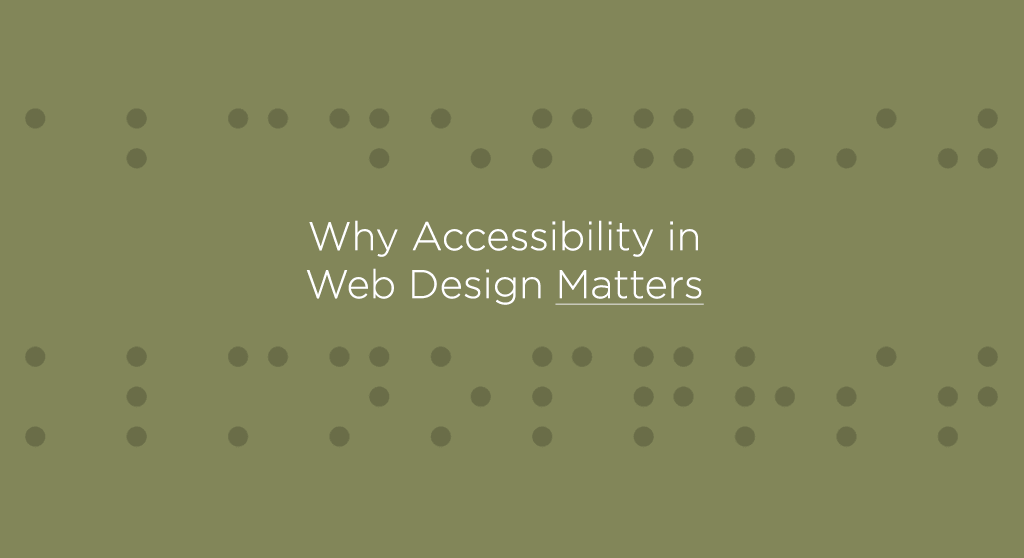
If you’ve never thought about how accessible your website is, now would be a good time.
When you make design decisions, does accessibility ever factor into your color choices? What about other features on your website, such as the homepage slider or the menu navigation?
Many website owners don’t think about these aspects of their web design because they aren’t aware of them. They blithely add sliders onto their senior care website, unaware of how disorienting these can be to older users. They pick colors based on personal preferences without realizing ways in which these color choices can affect the experience of color-blind users on their sites, or how the lack of contrast can make it difficult to see links.
These may seem like trivial matters, but they have significant ramifications for anyone with a disability or impairment who wants to use your website. The bottom line is, accessibility matters. Here’s why.
1. People who can’t access your site can’t become your customers.
On a more practical level, accessibility affects your bottom line. If your brick-and-mortar store doesn’t have a wheelchair-accessible entrance, or if the aisles are too narrow, or if there’s no elevator to an upper floor, visitors in wheel chairs won’t be able to enter your building and buy your products.
The same can be said of the Internet. If you don’t have screen reader compatibility, or if your videos don’t have subtitles, or if you use visual CAPTCHA without alternatives for users who can’t see them, you’re effectively locking those potential customers out of your store.
And unlike in a physical location, where adding these accommodations might be prohibitively expensive, doing so on the Internet is relatively cheap.
2. Accessibility is good for SEO.
Google is blind. So in many ways, Google analyzes the structure and content of your site much the same way as a screen reader. Headers, alt text on images, subtitles on video content, and transcripts of audio content are all ways you can add content and meta data to your website in ways that improve your SEO. And, coincidentally, in doing so you also create a website that is more accessible for the visually and hearing impaired.
3. Accessibility and usability go hand-in-hand.
As the Internet has evolved, many of the principles of good design have converged with those of accessibility and usability:
- Large blocks of text with minimal formatting and a small font are hard to read and difficult for screen readers to navigate. They also look cold and unwelcoming.
- Carousels on websites can be disorienting for the elderly and people with a limited field of vision. They’re also a tacky and irritating way to cram in more content.
- Navigation menus with multiple tiers of navigation that require careful user control to click on without disappearing are frustrating for all of us. All the more so for users with motor control difficulties.
The point is: if you want to create a better user experience, accessibility will help you get there.
4. Accessibility affects all of us.
As the above should indicate, accessible websites are easier to use. A website that can be used by a one-handed person is also accessible to the parent holding a squirming toddler, to the commuter holding on to the subway rail while scanning their phone, and to the person who just broke their arm playing sports.
There are also far more of us with accessibility concerns than you might realize. For instance, one study shows that 8.6% of the American population has some form of hearing impairment. Meanwhile, according to the National Federation of the Blind, and estimated 2.3% of adults 16 or older have some form of visual impairment. Combined, that’s over 10% of the population, and that’s before you take into various motor disabilities commonly faced by the elderly.
We can continue to ignore accessibility, but we may come to regret it once we’re older and struggling to read a website with tiny text.
5. Accessibility makes the world a better place.
This is a pretty obvious statement, but it can’t go unsaid. The main reason we should care about accessibility is that none of us wants to have a website that makes life harder for people who already have jump through extra hoops to accomplish basic tasks.
For a person with a disability, not being able to access your website might prevent them from finding important information they need for a school assignment, being able to complete a purchase, or holding down a job.
Is perfect accessibility in web design possible?
One question that many business owners wonder is whether it is even possible to attain perfect accessibility in web design. After all, there’s such a wide range of disabilities, accounting for all of them seems like a daunting task. And what if the accommodations for one disability conflict with those for another? How much can we really expect from a small business whose primary goal is to stay afloat in a competitive market?
This is a reasonable concern for business owners to ask, and we by no means want to imply that people who fail to achieve perfect accessibility on their websites are awful people. However, I believe that many business owners feel so overwhelmed by the subject of accessibility that rather than take advantage of a few easy wins that could vastly improve their site’s performance, they avoid taking any action at all.
In reality, web accessibility follows the 80/20 rule: you can get a mostly accessible website with relatively minimal effort before you hit the point of diminishing returns.
If accessibility were hard to achieve, then there might be reason to believe an average business couldn’t afford to implement it on their website. But the good news is that you can address the majority of your accessibility errors with relative ease. All it takes is the right information and a little diligence.
Stay tuned as we introduce you to some specific ways to improve your website accessibility later this week.






